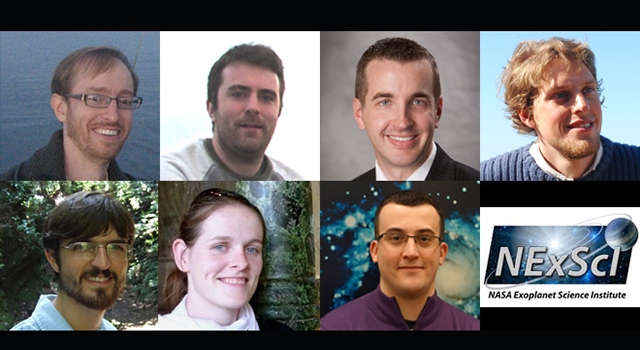Apr 3 2014
NASA has selected seven scientists as recipients of the 2014 Carl Sagan Exoplanet Postdoctoral Fellowships. The fellowship, named for the late astronomer, was created to inspire the next generation of explorers seeking to learn more about planets, and possibly life, around other stars.
 The 2014 Carl Sagan Fellows (left to right): Ian Crossfield, Lunar and Planetary Lab, Tucson, Ariz.; Matthew Penny, Ohio State University, Columbus, Ohio; Kevin Stevenson, University of Chicago, Illinois; Vivien Parmentier, University of California, Santa Cruz.; Timothy Brandt, Advanced Study in Princeton, N.J.; Jayne Birkby, Harvard College Observatory, Cambridge, Mass.; Roberto Sanchis Ojeda, University of California, Berkeley. Image credit: NASA/JPL-Caltech
The 2014 Carl Sagan Fellows (left to right): Ian Crossfield, Lunar and Planetary Lab, Tucson, Ariz.; Matthew Penny, Ohio State University, Columbus, Ohio; Kevin Stevenson, University of Chicago, Illinois; Vivien Parmentier, University of California, Santa Cruz.; Timothy Brandt, Advanced Study in Princeton, N.J.; Jayne Birkby, Harvard College Observatory, Cambridge, Mass.; Roberto Sanchis Ojeda, University of California, Berkeley. Image credit: NASA/JPL-Caltech
The primary goal of the fellowship program is to support outstanding recent postdoctoral scientists in conducting independent research related to the science goals of NASA's Exoplanet Exploration Program, namely, to discover and characterize planetary systems and Earth-like planets around nearby stars.
Significant discoveries and advances have already been made by previous Sagan Fellows. Recently, two Sagan fellows obtained the first ground-based optical image of an exoplanet. The technological advances they helped to enable have allowed them to take a picture of an extra-solar planet with essentially the same sensor as in your digital camera .
"The revolution in the discovery and characterization of planets beyond our solar system continues at a dramatic pace, and this year's Sagan Fellows will make important contributions to this dynamic field," said Charles Beichman, executive director of the NASA Exoplanet Science Institute at the California Institute of Technology in Pasadena. "These young scientists will explore emerging new methods of finding planets through direct imaging and microlensing and develop innovative observational and theoretical tools for studying the atmospheres of these distant worlds."
The fellowship program, for selected postdoctoral scientists, was created in 2008.
The 2014 Sagan Fellows are:
- Jayne Birkby, who will work at Harvard College Observatory in Cambridge, Mass., on "The Giant Planet Playground: Towards the Characterization of Earth Analogues." Birkby will use high-resolution ground-based spectroscopy to detect molecules in exoplanet atmospheres and identify biomarkers in Earth-like planets in the habitable zones of M-dwarf stars.
- Timothy Brandt, who will work at the Institute for Advanced Study in Princeton, N.J., on "Speckle Suppression for High-Contrast Integral-Field Spectroscopy." Brandt will help to build a camera that takes separate images of extrasolar planets at all wavelengths at once to see extremely faint worlds and learn about their temperatures and compositions.
- Ian Crossfield, who will work at the Lunar and Planetary Lab in Tucson, Ariz., on "Spectroscopy and Cartography of Cool Extrasolar Atmospheres." Ian will focus on understanding hazy atmospheres and clouds of extrasolar "super-Earth" planets and hot gas giants. He will also produce global maps and weather movies of cloudy brown dwarfs.
- Vivien Parmentier, who will work at the University of California in Santa Cruz, Calif., on "Dynamical Exoplanet Atmospheres: Mixing, Clouds and Interaction with the Interior." He will study some of the most exotic exoplanet atmospheres in order to see how they influence the radii of hot Jupiters and mini-Neptunes.
- Matthew Penny, who will work at Ohio State University in Columbus, Ohio, on "Measuring the Galactic Distribution of Exoplanets." He will use the growing number of planets discovered by gravitational microlensing searches to estimate the frequency of planets around stars in different parts of our Milky Way galaxy to determine whether the large-scale galactic environment affects planetary systems.
- Roberto Sanchis Ojeda, who will work at the University of California, Berkeley, on "The Shortest-Period Planets." He will use the vast amount of current data available, along with data in upcoming missions, to explore the diversity of super-Earth and Earth-like planet compositions.
- Kevin Stevenson, who will work at the University of Chicago, Illinois, on "One Earth, Two Earth, Red Earth, Blue Earth: The Taxonomy of Extrasolar Planets." He will measure the atmospheric composition and chemical properties of extrasolar planets to constrain their nature and origin by developing a more rigorous exoplanet classification scheme. The ultimate goal is to identify the pertinent classification markers that will indicate the potential for life.
NASA has two other astrophysics theme-based fellowship programs: the Einstein Fellowship Program, which supports research into the physics of the cosmos, and the Hubble Fellowship Program, which supports research into cosmic origins. The Sagan Fellowship Program is administered by the NASA Exoplanet Science Institute as part of NASA's Exoplanet Exploration Program at JPL. Caltech manages JPL for NASA.
For more information about the NASA Exoplanet Science Institute, visit: http://nexsci.caltech.edu
The California Institute of Technology manages JPL for NASA.